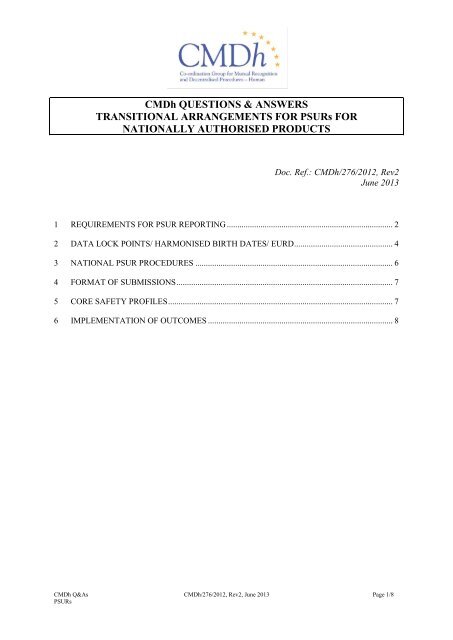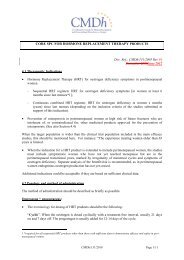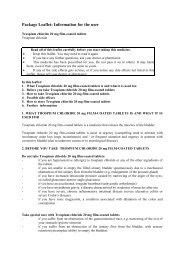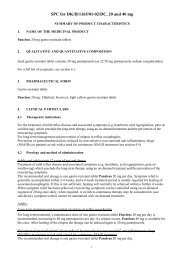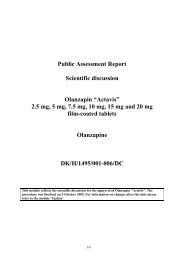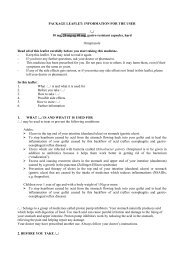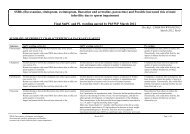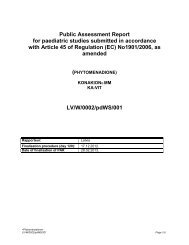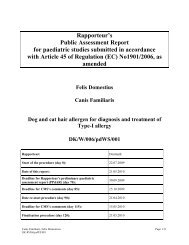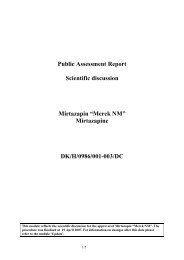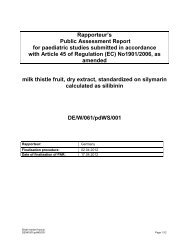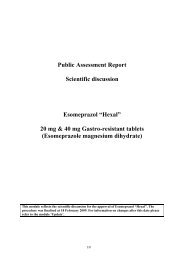CMDh_276_2012_Rev2_2013_06_-_clean.pdf
CMDh_276_2012_Rev2_2013_06_-_clean.pdf
CMDh_276_2012_Rev2_2013_06_-_clean.pdf
You also want an ePaper? Increase the reach of your titles
YUMPU automatically turns print PDFs into web optimized ePapers that Google loves.
<strong>CMDh</strong> QUESTIONS & ANSWERS<br />
TRANSITIONAL ARRANGEMENTS FOR PSURs FOR<br />
NATIONALLY AUTHORISED PRODUCTS<br />
Doc. Ref.: <strong>CMDh</strong>/<strong>276</strong>/<strong>2012</strong>, <strong>Rev2</strong><br />
June <strong>2013</strong><br />
1 REQUIREMENTS FOR PSUR REPORTING ............................................................................... 2<br />
2 DATA LOCK POINTS/ HARMONISED BIRTH DATES/ EURD ............................................... 4<br />
3 NATIONAL PSUR PROCEDURES .............................................................................................. 6<br />
4 FORMAT OF SUBMISSIONS ....................................................................................................... 7<br />
5 CORE SAFETY PROFILES ........................................................................................................... 7<br />
6 IMPLEMENTATION OF OUTCOMES ........................................................................................ 8<br />
<strong>CMDh</strong> Q&As <strong>CMDh</strong>/<strong>276</strong>/<strong>2012</strong>, <strong>Rev2</strong>, June <strong>2013</strong> Page 1/8<br />
PSURs
Nationally Authorised Product (NAP) is intended to encompass medicines authorised through Mutual<br />
Recognition and Decentralised Procedures and purely nationally authorised products where authorised<br />
in more than one Member State. The following questions and answers cover transition arrangements<br />
for PSURs following implementation of new pharmacovigilance legislation 21 st July <strong>2012</strong> and the<br />
introduction of the single PSUR assessment for NAPs. This document should be read in conjunction<br />
with the Questions and answers on practical transitional measures for the implementation of the<br />
pharmacovigilance legislation, published by EMA.<br />
http://www.ema.europa.eu/docs/en_GB/document_library/Regulatory_and_procedural_guideline/<strong>2012</strong><br />
/05/WC5001<strong>276</strong>58.<strong>pdf</strong><br />
1 REQUIREMENTS FOR PSUR REPORTING<br />
1.1 For which products will routine PSUR reporting not be required?<br />
Unless there is a specific condition in the authorisation or it is indicated otherwise in<br />
the EURD for the substance concerned, routine PSUR reporting will not be required<br />
for medicinal products authorised under the following articles of Directive<br />
2001/83/EC:<br />
• Article 10.1 generic<br />
• Article 10.a well established use<br />
• Article 14 homeopathic medicine<br />
• Article 16a traditional herbal medicine<br />
1.2 For which types of products will routine PSUR reporting be required?<br />
Reporting will be required for medicinal products authorised under the following<br />
articles of Directive 2001/83:<br />
• Article 8(3) full dossier<br />
• Article 10.3 hybrid application<br />
• Article 10.4 biosimilar<br />
• Article 10b fixed combination<br />
• Article 10c informed consent<br />
• Any other product where there is a specific condition for PSUR reporting in the<br />
authorisation.<br />
• Where it is indicated in the EURD that, for the substance concerned, for products<br />
normally covered by the derogation, reporting is required.<br />
• In addition a PSUR shall be submitted upon the request of a Competent Authority.<br />
1.3 We are unclear whether routine PSUR reporting will still be required for our<br />
product authorised under MRP/DCP how can be confirm this?<br />
The legal basis under which the product was authorised in the Reference Member<br />
State is key to deciding whether the product is covered by the derogation. For example<br />
if the product was approved under Article 10.1 in the RMS and there is no indication<br />
in the EURD that reporting is required for generic products, then reporting will not be<br />
required.<br />
<strong>CMDh</strong> Q&As <strong>CMDh</strong>/<strong>276</strong>/<strong>2012</strong>, <strong>Rev2</strong>, June <strong>2013</strong> Page 2/8<br />
PSURs
1.4 Our product was authorised under older legislation, Article 4.8 of Directive<br />
65/65; will we be required to submit PSURs?<br />
For products authorised under Article 4.8a(ii) (well established use) or Article 4.8a(iii)<br />
(1 st paragraph) (essential similarity) under Directive 65/65 and Articles 10.1 a(ii) and 10 a<br />
(iii) of Directive 2001/83/EC (before re-codification) reporting will not be required unless<br />
there is a specific condition in the authorisation or there is an indication in the EURD<br />
that PSUR reporting is required. PSUR reporting would be required for products<br />
authorised under Articles 4.8 (full) , 4.8 a (i) (informed consent) and 4.8 a (iii) (2 nd<br />
paragraph) (hybrid application)/ 10.1/10/1 a(i).<br />
1.5 Our product was authorised some years ago and can be considered to be well<br />
established; can we stop PSUR reporting?<br />
PSUR reporting can only be stopped if the product was authorised under a legal basis<br />
covered by the derogation given in the legislation.<br />
1.6 When can we stop reporting for nationally authorised generics/well established<br />
use/homeopathics/herbals covered by the derogation?<br />
PSURs due for submission on or after 21 st July <strong>2012</strong>, i.e. those with a data lock point<br />
on or after 21 st May <strong>2012</strong>, do not need to be submitted if they are covered by the<br />
derogation, unless there is a specific condition in the authorisation or if it is indicated<br />
otherwise in the EURD for the substance concerned.<br />
1.7 We hold a MA for a product containing a substance listed on the ‘List of<br />
nationally approved substances for which periodic safety update reports are required<br />
for generic medicinal products during the transitional period’, what are the<br />
implications for us?<br />
Please refer to the cover note on this topic:<br />
http://www.hma.eu/fileadmin/dateien/Human_Medicines/CMD_h_/Pharmacovigilanc<br />
e_Legislation/<strong>CMDh</strong>-282-<strong>2012</strong>-Rev0.<strong>pdf</strong><br />
The Member States have reviewed the substances that have a harmonised data lock<br />
point between the date of implementation of the legislation (July <strong>2012</strong>) and the date<br />
that the EURD became legally binding (April <strong>2013</strong>) and have compiled a list of<br />
nationally authorised substances for which PSURs are required for generic medicinal<br />
products during this period. The NCAs consider that during the transitional period up<br />
to 1 st April <strong>2013</strong>, PSURs for generics are required for those substances listed on<br />
pharmacovigilance grounds.<br />
<strong>CMDh</strong> Q&As <strong>CMDh</strong>/<strong>276</strong>/<strong>2012</strong>, <strong>Rev2</strong>, June <strong>2013</strong> Page 3/8<br />
PSURs
2 DATA LOCK POINTS/ HARMONISED BIRTH DATES/ EURD<br />
2.1 The EURD became binding 1 st April <strong>2013</strong> however some substances have been<br />
removed from the EURD. Which DLPs and Frequencies should be followed for<br />
these substances?<br />
Substances that are included in the EURD must follow the EU single assessment<br />
procedure for PSURs. This procedure has not yet been fully implemented for<br />
nationally authorised products and therefore substances that are not centrally<br />
authorised and have DLPs in <strong>2013</strong>/2014 have been removed from the EURD for the<br />
time being but have been included in an extended PSUR work sharing list entitled<br />
“List of substances under PSUR Work Sharing scheme and other substances contained<br />
in Nationally Authorised Products with DLP synchronised” due to the fact that they<br />
will not be subject to an EU single assessment of PSURs until further notice.<br />
For more details, please refer to the <strong>CMDh</strong> webpage dedicated to the PSUR Work<br />
sharing, particularly in the document “Assessment of Periodic Safety Update Reports<br />
for National Authorised Products in <strong>2013</strong>/2014 - Cover note”:<br />
http://www.hma.eu/348.html .<br />
For products containing an active substance or combination of active substances<br />
temporally removed from the EURD list which include an explicit condition providing<br />
for a specific frequency or PSUR submission date, PSURs shall be submitted in<br />
accordance with this particular condition instead of following the DLPs given in the<br />
EURD list.<br />
2.2 Do we have to submit variations to align our products with the PSUR data lock<br />
points and frequencies listed in the EURD list?<br />
For advice on Centrally Authorised Products please refer to the EMA Q&As on<br />
Practical Transitional Measures for the Implementation of the Pharmacovigilance<br />
Legislation.<br />
http://www.ema.europa.eu/docs/en_GB/document_library/Regulatory_and_procedural<br />
_guideline/<strong>2012</strong>/05/WC5001<strong>276</strong>58.<strong>pdf</strong><br />
For nationally authorised products granted before 21 st July <strong>2012</strong>, that did not have a<br />
legal obligation in the authorisation for PSUR frequency of submission, the EURD<br />
will become mandatory six months after publication and a variation will not be<br />
required to align with the EURD.<br />
2.3 Why is the PSUR frequency included in the EURD list different to the period<br />
covering the last DLP of my product and the DLP currently in the EURD list?<br />
(Example: According to the EURD list, the DLP of the substance included in my<br />
product is 2018 and the submission frequency 6 years. However, the last PSUR<br />
was submitted in 2010. Will we need to submit a 2 year report in addition to the 6<br />
year report?)<br />
The PSUR submission frequency and DLP included in the list aim at harmonising the<br />
submission of PSURs for products containing the same active substances. Products<br />
may currently have different DLPs and therefore the period between the last PSUR<br />
<strong>CMDh</strong> Q&As <strong>CMDh</strong>/<strong>276</strong>/<strong>2012</strong>, <strong>Rev2</strong>, June <strong>2013</strong> Page 4/8<br />
PSURs
submitted and the 1st PSUR submitted according to the EURD list may be different<br />
to the frequency given in the EURD. This frequency as stated in the list will<br />
therefore be applied, if still relevant, by all MAHs concerned as of the 2nd PSUR.<br />
2.4 In the EURD list DLPs are fixed on a certain date of the month in contrast to<br />
the Work-sharing list. Can I submit my PSUR according to any day in the<br />
month of the DLP published in the EURD list?<br />
Unlike the PSUR Work-sharing list, the DLPs in the EURD list are fixed on a certain<br />
date and are legally binding, therefore they should be followed.<br />
This enables the synchronisation of submission of PSURs for products subject to<br />
different MAs and facilitates the single assessment of PSURs.<br />
2.5 My substance appears in both the EURD list and the “List of substances under<br />
PSUR Work Sharing scheme and other substances contained in Nationally<br />
Authorised Products with DLP synchronised”. According to which list should I<br />
submit my PSUR?<br />
On 1st of April <strong>2013</strong>, the EURD list became legally binding. This means that PSURs<br />
of products containing the substances and combinations of substances included in the<br />
list shall be submitted in line with the PSUR frequency and Data Lock Point (DLP)<br />
specified in the EURD list. These PSURs will be subject to an EU single assessment<br />
performed by the Pharmacovigilance and Risk Assessment Committee (PRAC).<br />
The 6 months period between the publication of the EURD list (1st October <strong>2012</strong>) and<br />
the date when it became binding, (1st April <strong>2013</strong>, see Article 107c(7) of Directive<br />
2010/84/EU), has been considered as a “transitional period” where PSURs shall be<br />
submitted in line with the periodicity and DLP agreed during this period of time for<br />
each product. Therefore, any DLP given in the “List of substances under PSUR Work<br />
Sharing scheme and other substances contained in Nationally Authorised Products<br />
with DLP synchronised” that are preceding the DLPs given in the EURD list (i.e.<br />
falling before the 1st April <strong>2013</strong>), should be followed by MAHs of the products<br />
concerned for the submission of their PSURs. Such DLP may have been established in<br />
the frame of the PSUR work Sharing and Synchronisation project.<br />
The next PSURs should therefore be submitted according to the DLP as stated in the<br />
“List of substances under PSUR Work Sharing scheme and other substances contained<br />
in Nationally Authorised Products with DLP synchronized”, as at this date, the EURD<br />
list had not yet taken effect. These PSURs will be assessed at a national level. The<br />
subsequent PSURs will have to be submitted based on the EURD list.<br />
2.6 When a PSUR cycle has been changed is it sufficient to rely on the EURD list or<br />
do we have to notify the NCAs to inform them that the PSUR, which was due on<br />
a specific date, will be submitted in line with the EURD list instead?<br />
You can rely on the EURD list and there is no need to notify the NCAs.<br />
<strong>CMDh</strong> Q&As <strong>CMDh</strong>/<strong>276</strong>/<strong>2012</strong>, <strong>Rev2</strong>, June <strong>2013</strong> Page 5/8<br />
PSURs
3 NATIONAL PSUR PROCEDURES<br />
3.1 What procedures should be followed for PSUR submissions from 21 st July <strong>2012</strong>?<br />
For active substances and combinations of active substances contained in centrally<br />
authorised medicines and in both centrally and nationally authorised medicines subject<br />
to different marketing authorisations and authorised in more than one Member State<br />
for which data lock points and frequency of submission of PSURs have been<br />
harmonised (EURD List) the EU single assessment procedures procedure involving<br />
the PRAC will apply.<br />
For active substances contained only in nationally authorised medicines subject to<br />
different marketing authorisations and authorised in more than one Member State the<br />
current procedures will apply i.e. either mutual recognition or national procedure until<br />
the EU single assessment procedure is implemented.<br />
Such active substances and combinations of active substances originally included in<br />
the EURD list with a DLP in <strong>2013</strong> until 31 August 2014 have been removed from the<br />
EURD list and transferred to the new list: “List of substances under PSUR Work<br />
Sharing scheme and other substances contained in Nationally Authorised Products<br />
with DLP synchronised.<br />
For products containing an active substance or combination of active substances<br />
included in the PSUR work sharing scheme, the current PSUR WS procedures without<br />
PRAC involvement will apply. Until the EU single assessment procedure for these<br />
products is implemented MAHs should continue to submit PSURs following the work<br />
sharing scheme<br />
For purely nationally authorised medicinal products authorised in only one Member<br />
State, the assessment of the PSUR will remain at an individual national level.<br />
3.2 Is PSUR work sharing compulsory?<br />
Participation in PSUR work sharing continues on an informal basis. The MAHs are<br />
encouraged to participate where PSUR submissions are required.<br />
3.3 Can further substances, currently on the list of synchronised birth dates be<br />
included in work sharing?<br />
If PSUR reporting is required for the product authorised to you please contact the<br />
EMA ( P-PV-Helpdesk@ema.europa.eu ) regarding inclusion of the substance/product<br />
in the work sharing project. A Reference Member State will need to be assigned for<br />
the PSUR assessment (P-RMS) and it would be very helpful if MAHs could<br />
informally agree with an NCA beforehand whether they would be willing to take on<br />
the responsibilities of the P-RMS.<br />
<strong>CMDh</strong> Q&As <strong>CMDh</strong>/<strong>276</strong>/<strong>2012</strong>, <strong>Rev2</strong>, June <strong>2013</strong> Page 6/8<br />
PSURs
3.4 In the Good Vigilance Practice Module VII it is stated that PSURs should be<br />
submitted within 70 calendar days of the DLP for PSURs covering intervals up to<br />
12 months and within 90 calendar days of the DLP for PSURs covering intervals<br />
in excess of 12 months; will this apply to nationally authorised products?<br />
Yes, the 70 and 90 day periods between data lock and submission will apply for all<br />
PSUR procedures.<br />
3.5 If an NCA is requesting a PSUR for a product where the generic products do not<br />
need submit a PSUR according to the List of substances under PSUR Work<br />
Sharing scheme and other substances contained in Nationally Authorised Products<br />
with DLP synchronized, does the MAH have to submit the PSUR to all NCAs<br />
where the product is authorized or only to the NCA who are requesting the<br />
PSUR?<br />
If only one NCA is requesting a PSUR the MAH should only submit the PSUR to the<br />
requesting NCA. If more than one NCA is requesting a PSUR the MAH should submit<br />
the PSUR to all MS where the product is authorized.<br />
4 FORMAT OF SUBMISSIONS<br />
4.1 Which dossier format should be used for PSURs from July <strong>2012</strong>?<br />
The objective of the PSUR is to present a comprehensive and critical analysis of the<br />
risk-benefit balance of the product taking into account new or emerging safety<br />
information in the context of cumulative information on risks and benefits. Therefore<br />
the format has been revised and the new format is given in GVP Module VII.B.5.<br />
Commission Implementing Regulation (EU) No 520/<strong>2012</strong> allowed a six month<br />
transition period up to 10 th January <strong>2013</strong> for introduction of the new format.<br />
PSURs submitted after 10 th January <strong>2013</strong> must be in the new format given in the GVP<br />
module.<br />
5 CORE SAFETY PROFILES<br />
5.1 Under previous arrangements for work sharing where the PSURS were<br />
submitted in Volume 9A format, the innovator company was required to include<br />
a proposal for a Core Safety Profile (CSP) in the PSUR dossier; will this still be<br />
required?<br />
During the transition period up to 10 th January <strong>2013</strong> a proposal for a CSP was required<br />
for PSURs submitted with ‘old’ format (Volume 9A) PSURs in the work sharing<br />
scheme. Since 10 th January PSURs are required to be submitted according to the new<br />
content and format and CSPs will not be required. Reference should be made to GVP<br />
Module VII.B.4 regarding reference documentation.<br />
<strong>CMDh</strong> Q&As <strong>CMDh</strong>/<strong>276</strong>/<strong>2012</strong>, <strong>Rev2</strong>, June <strong>2013</strong> Page 7/8<br />
PSURs
5.2 Will a final CSP be available at the end of the procedure?<br />
A CSP may be finalised for PSURs submitted in ‘old’ (Volume 9A) format during the<br />
transition period up to 10 th January <strong>2013</strong>. CSPs will not be published for PSURs<br />
submitted and assessed under the new benefit-risk format. However, the conclusions<br />
of the assessment will be published.<br />
5.3 Will existing CSPs be updated?<br />
CSPs are only required for PSURs submitted under ‘old’ Volume 9A format. As the<br />
new format benefit-risk evaluation PSURs are introduced existing CSPs will not be<br />
required and therefore existing CSPs will not be updated.<br />
6 IMPLEMENTATION OF OUTCOMES<br />
6.1 Our product is a generic authorised under Article 10.1 and we will therefore not be<br />
involved in the next work sharing procedure for the active substance. How will we<br />
be informed of the outcome of the work sharing assessment?<br />
The outcome of the assessment will be published on the HMA web site. MAHs should<br />
review the information published and if as a result amendments are needed to their<br />
generic product, the appropriate variation should be submitted within 120 days.<br />
<strong>CMDh</strong> Q&As <strong>CMDh</strong>/<strong>276</strong>/<strong>2012</strong>, <strong>Rev2</strong>, June <strong>2013</strong> Page 8/8<br />
PSURs


